A Critical Analysis of Cost Sharing Mechanisms in Healthcare Systems
VerifiedAdded on 2021/02/19
|7
|1919
|88
Report
AI Summary
This report critically analyzes cost-sharing mechanisms in healthcare, focusing on both supply-side and demand-side strategies. It begins with an introduction to the welfare case for insurance and the concept of moral hazard, discussing how insurance can increase healthcare demand and potentially lead to inefficiencies. The report then evaluates the limitations of demand-side cost sharing, emphasizing the role of incentives and risk spreading. It explores the concept of supply-side incentives, examining how they can directly influence provider behavior and potentially improve efficiency. The report critiques the views of Randall Ellis and Thomas McGuire, providing an in-depth analysis of various objectives for supply-side cost sharing, including incentives for technology adoption, fairness to customers and healthcare providers. The report highlights the arguments for and against cost sharing, supported by various authors and their views. It concludes by summarizing the complexities of cost sharing, highlighting its implications for healthcare reform and the balance between appropriate incentives and risk spreading. The report also provides a detailed list of references.
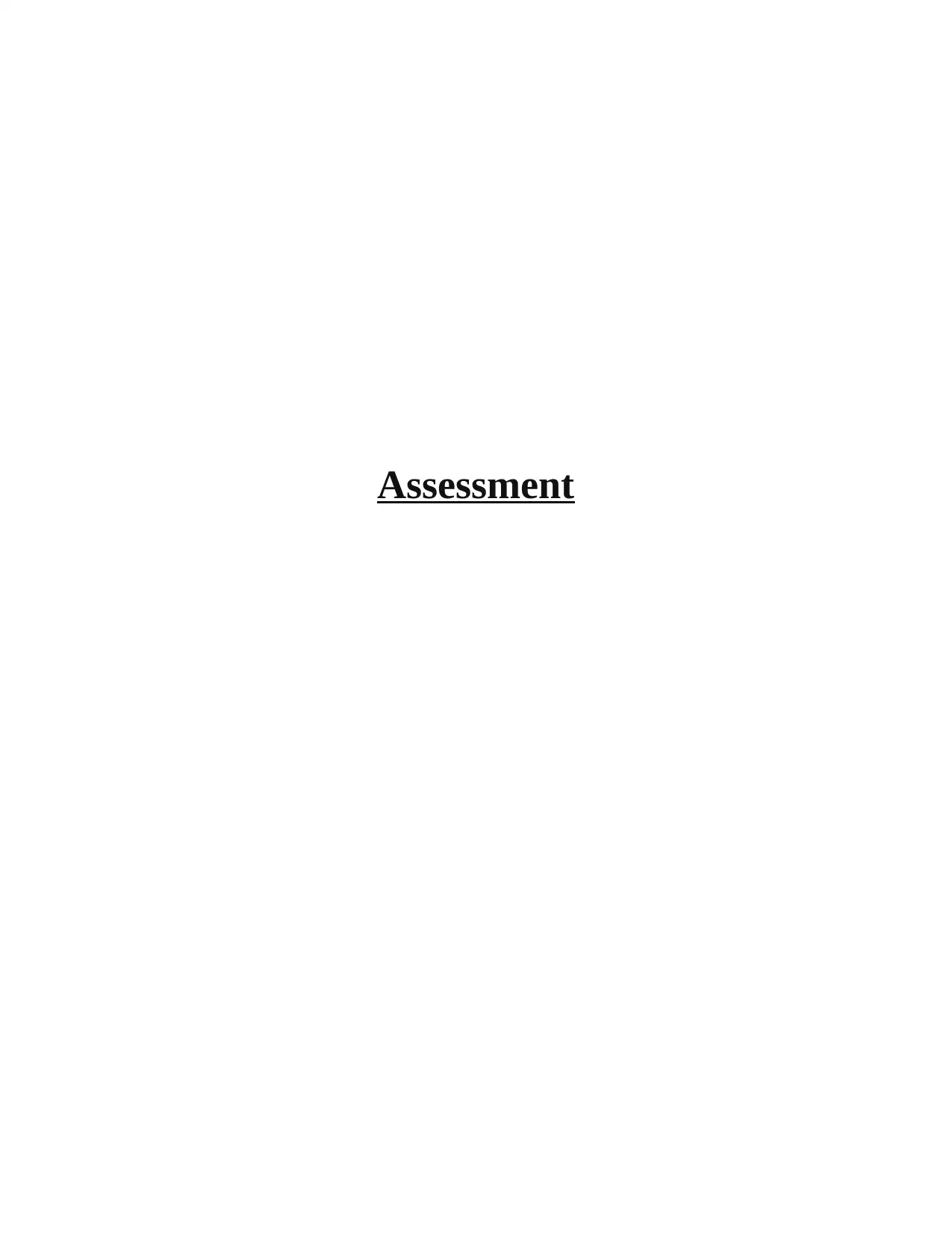
Assessment
Secure Best Marks with AI Grader
Need help grading? Try our AI Grader for instant feedback on your assignments.
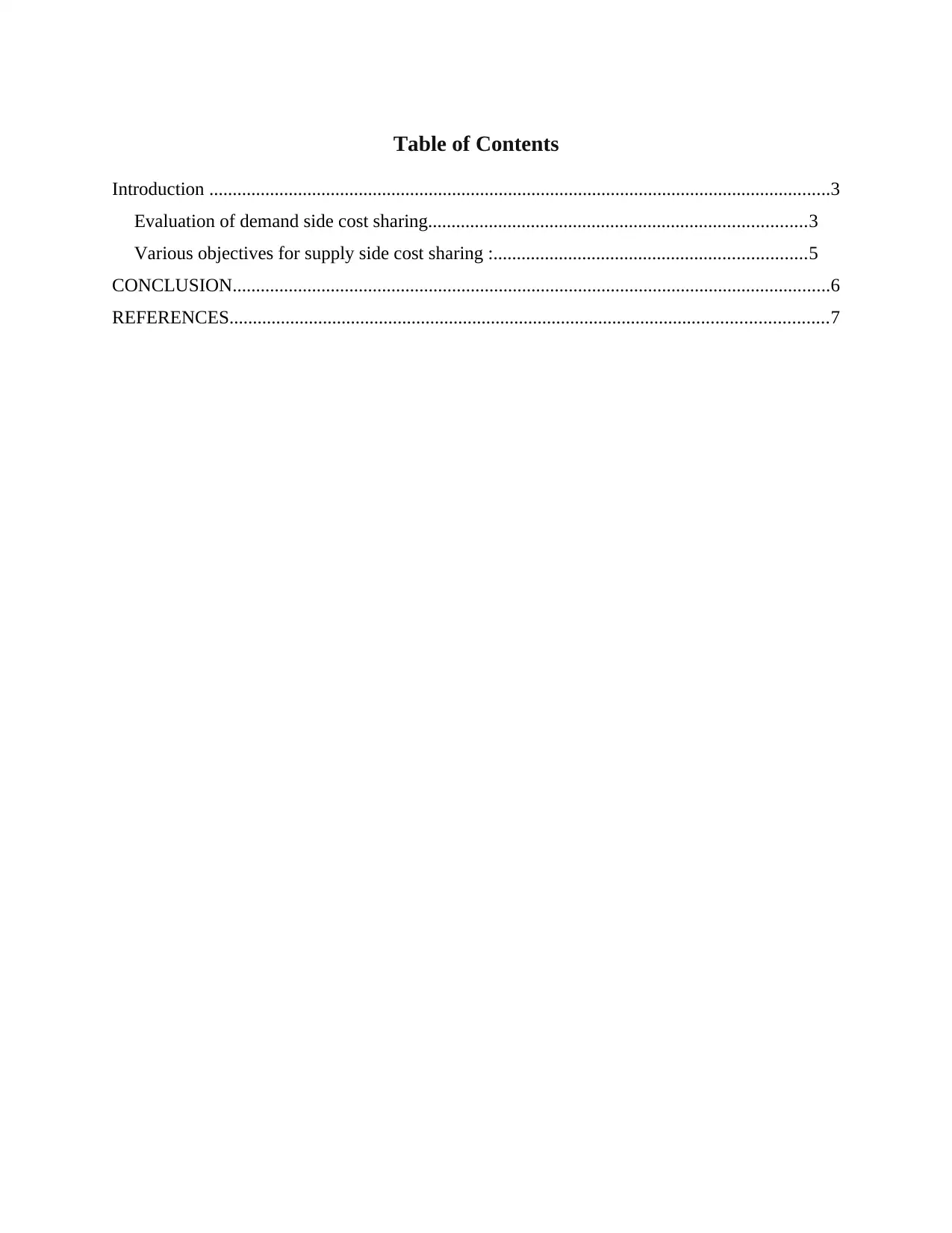
Table of Contents
Introduction .....................................................................................................................................3
Evaluation of demand side cost sharing.................................................................................3
Various objectives for supply side cost sharing :...................................................................5
CONCLUSION................................................................................................................................6
REFERENCES................................................................................................................................7
Introduction .....................................................................................................................................3
Evaluation of demand side cost sharing.................................................................................3
Various objectives for supply side cost sharing :...................................................................5
CONCLUSION................................................................................................................................6
REFERENCES................................................................................................................................7
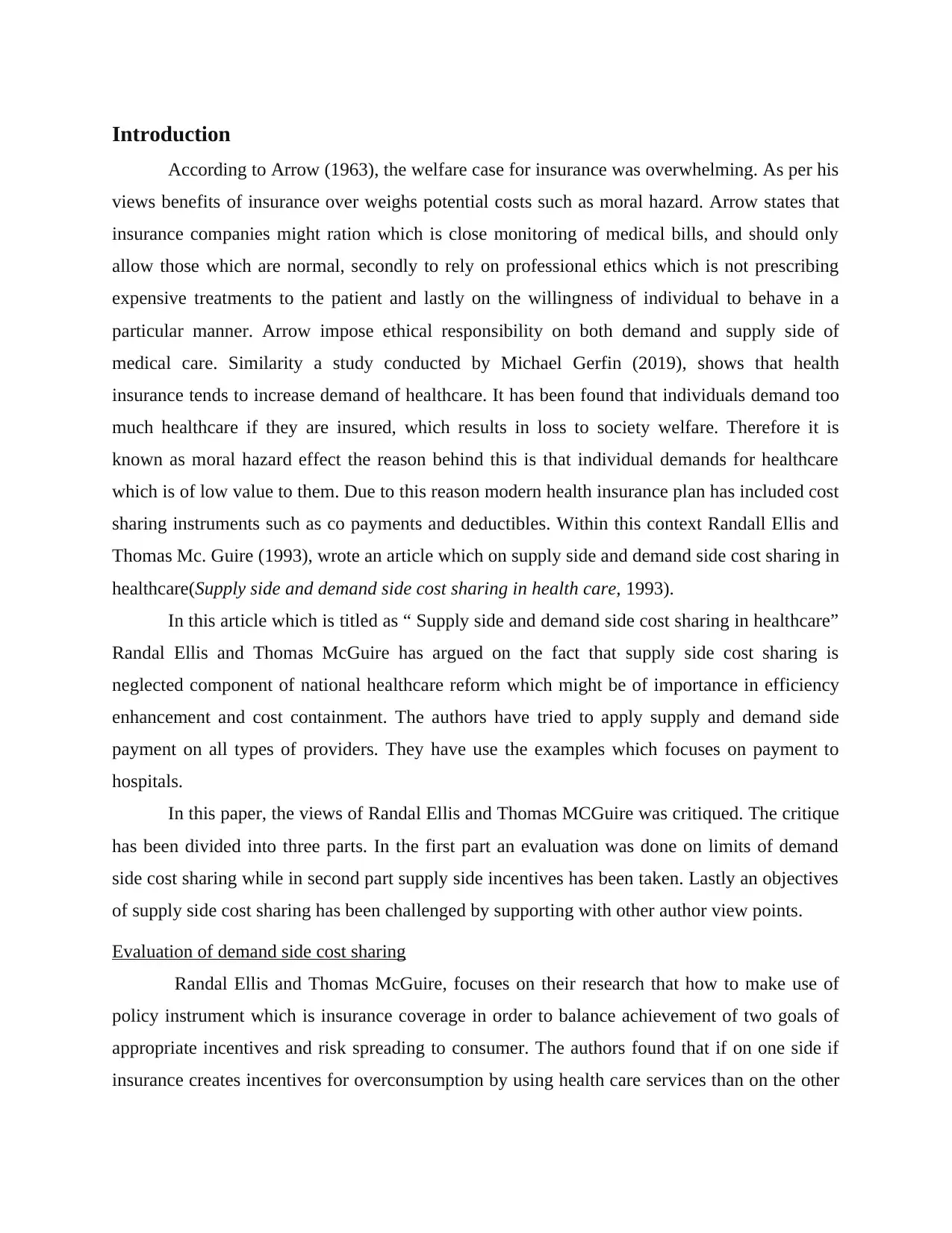
Introduction
According to Arrow (1963), the welfare case for insurance was overwhelming. As per his
views benefits of insurance over weighs potential costs such as moral hazard. Arrow states that
insurance companies might ration which is close monitoring of medical bills, and should only
allow those which are normal, secondly to rely on professional ethics which is not prescribing
expensive treatments to the patient and lastly on the willingness of individual to behave in a
particular manner. Arrow impose ethical responsibility on both demand and supply side of
medical care. Similarity a study conducted by Michael Gerfin (2019), shows that health
insurance tends to increase demand of healthcare. It has been found that individuals demand too
much healthcare if they are insured, which results in loss to society welfare. Therefore it is
known as moral hazard effect the reason behind this is that individual demands for healthcare
which is of low value to them. Due to this reason modern health insurance plan has included cost
sharing instruments such as co payments and deductibles. Within this context Randall Ellis and
Thomas Mc. Guire (1993), wrote an article which on supply side and demand side cost sharing in
healthcare(Supply side and demand side cost sharing in health care, 1993).
In this article which is titled as “ Supply side and demand side cost sharing in healthcare”
Randal Ellis and Thomas McGuire has argued on the fact that supply side cost sharing is
neglected component of national healthcare reform which might be of importance in efficiency
enhancement and cost containment. The authors have tried to apply supply and demand side
payment on all types of providers. They have use the examples which focuses on payment to
hospitals.
In this paper, the views of Randal Ellis and Thomas MCGuire was critiqued. The critique
has been divided into three parts. In the first part an evaluation was done on limits of demand
side cost sharing while in second part supply side incentives has been taken. Lastly an objectives
of supply side cost sharing has been challenged by supporting with other author view points.
Evaluation of demand side cost sharing
Randal Ellis and Thomas McGuire, focuses on their research that how to make use of
policy instrument which is insurance coverage in order to balance achievement of two goals of
appropriate incentives and risk spreading to consumer. The authors found that if on one side if
insurance creates incentives for overconsumption by using health care services than on the other
According to Arrow (1963), the welfare case for insurance was overwhelming. As per his
views benefits of insurance over weighs potential costs such as moral hazard. Arrow states that
insurance companies might ration which is close monitoring of medical bills, and should only
allow those which are normal, secondly to rely on professional ethics which is not prescribing
expensive treatments to the patient and lastly on the willingness of individual to behave in a
particular manner. Arrow impose ethical responsibility on both demand and supply side of
medical care. Similarity a study conducted by Michael Gerfin (2019), shows that health
insurance tends to increase demand of healthcare. It has been found that individuals demand too
much healthcare if they are insured, which results in loss to society welfare. Therefore it is
known as moral hazard effect the reason behind this is that individual demands for healthcare
which is of low value to them. Due to this reason modern health insurance plan has included cost
sharing instruments such as co payments and deductibles. Within this context Randall Ellis and
Thomas Mc. Guire (1993), wrote an article which on supply side and demand side cost sharing in
healthcare(Supply side and demand side cost sharing in health care, 1993).
In this article which is titled as “ Supply side and demand side cost sharing in healthcare”
Randal Ellis and Thomas McGuire has argued on the fact that supply side cost sharing is
neglected component of national healthcare reform which might be of importance in efficiency
enhancement and cost containment. The authors have tried to apply supply and demand side
payment on all types of providers. They have use the examples which focuses on payment to
hospitals.
In this paper, the views of Randal Ellis and Thomas MCGuire was critiqued. The critique
has been divided into three parts. In the first part an evaluation was done on limits of demand
side cost sharing while in second part supply side incentives has been taken. Lastly an objectives
of supply side cost sharing has been challenged by supporting with other author view points.
Evaluation of demand side cost sharing
Randal Ellis and Thomas McGuire, focuses on their research that how to make use of
policy instrument which is insurance coverage in order to balance achievement of two goals of
appropriate incentives and risk spreading to consumer. The authors found that if on one side if
insurance creates incentives for overconsumption by using health care services than on the other
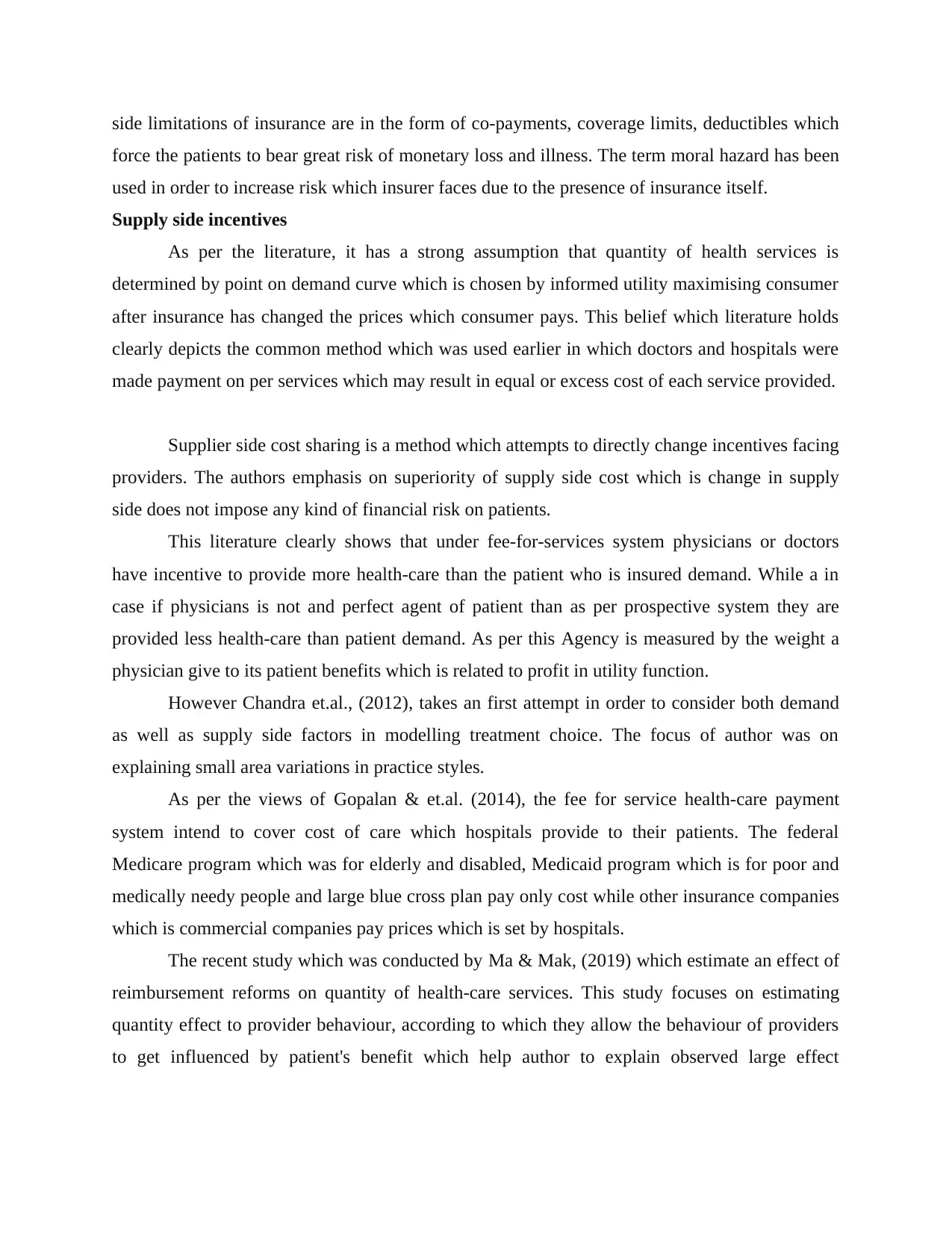
side limitations of insurance are in the form of co-payments, coverage limits, deductibles which
force the patients to bear great risk of monetary loss and illness. The term moral hazard has been
used in order to increase risk which insurer faces due to the presence of insurance itself.
Supply side incentives
As per the literature, it has a strong assumption that quantity of health services is
determined by point on demand curve which is chosen by informed utility maximising consumer
after insurance has changed the prices which consumer pays. This belief which literature holds
clearly depicts the common method which was used earlier in which doctors and hospitals were
made payment on per services which may result in equal or excess cost of each service provided.
Supplier side cost sharing is a method which attempts to directly change incentives facing
providers. The authors emphasis on superiority of supply side cost which is change in supply
side does not impose any kind of financial risk on patients.
This literature clearly shows that under fee-for-services system physicians or doctors
have incentive to provide more health-care than the patient who is insured demand. While a in
case if physicians is not and perfect agent of patient than as per prospective system they are
provided less health-care than patient demand. As per this Agency is measured by the weight a
physician give to its patient benefits which is related to profit in utility function.
However Chandra et.al., (2012), takes an first attempt in order to consider both demand
as well as supply side factors in modelling treatment choice. The focus of author was on
explaining small area variations in practice styles.
As per the views of Gopalan & et.al. (2014), the fee for service health-care payment
system intend to cover cost of care which hospitals provide to their patients. The federal
Medicare program which was for elderly and disabled, Medicaid program which is for poor and
medically needy people and large blue cross plan pay only cost while other insurance companies
which is commercial companies pay prices which is set by hospitals.
The recent study which was conducted by Ma & Mak, (2019) which estimate an effect of
reimbursement reforms on quantity of health-care services. This study focuses on estimating
quantity effect to provider behaviour, according to which they allow the behaviour of providers
to get influenced by patient's benefit which help author to explain observed large effect
force the patients to bear great risk of monetary loss and illness. The term moral hazard has been
used in order to increase risk which insurer faces due to the presence of insurance itself.
Supply side incentives
As per the literature, it has a strong assumption that quantity of health services is
determined by point on demand curve which is chosen by informed utility maximising consumer
after insurance has changed the prices which consumer pays. This belief which literature holds
clearly depicts the common method which was used earlier in which doctors and hospitals were
made payment on per services which may result in equal or excess cost of each service provided.
Supplier side cost sharing is a method which attempts to directly change incentives facing
providers. The authors emphasis on superiority of supply side cost which is change in supply
side does not impose any kind of financial risk on patients.
This literature clearly shows that under fee-for-services system physicians or doctors
have incentive to provide more health-care than the patient who is insured demand. While a in
case if physicians is not and perfect agent of patient than as per prospective system they are
provided less health-care than patient demand. As per this Agency is measured by the weight a
physician give to its patient benefits which is related to profit in utility function.
However Chandra et.al., (2012), takes an first attempt in order to consider both demand
as well as supply side factors in modelling treatment choice. The focus of author was on
explaining small area variations in practice styles.
As per the views of Gopalan & et.al. (2014), the fee for service health-care payment
system intend to cover cost of care which hospitals provide to their patients. The federal
Medicare program which was for elderly and disabled, Medicaid program which is for poor and
medically needy people and large blue cross plan pay only cost while other insurance companies
which is commercial companies pay prices which is set by hospitals.
The recent study which was conducted by Ma & Mak, (2019) which estimate an effect of
reimbursement reforms on quantity of health-care services. This study focuses on estimating
quantity effect to provider behaviour, according to which they allow the behaviour of providers
to get influenced by patient's benefit which help author to explain observed large effect
Secure Best Marks with AI Grader
Need help grading? Try our AI Grader for instant feedback on your assignments.
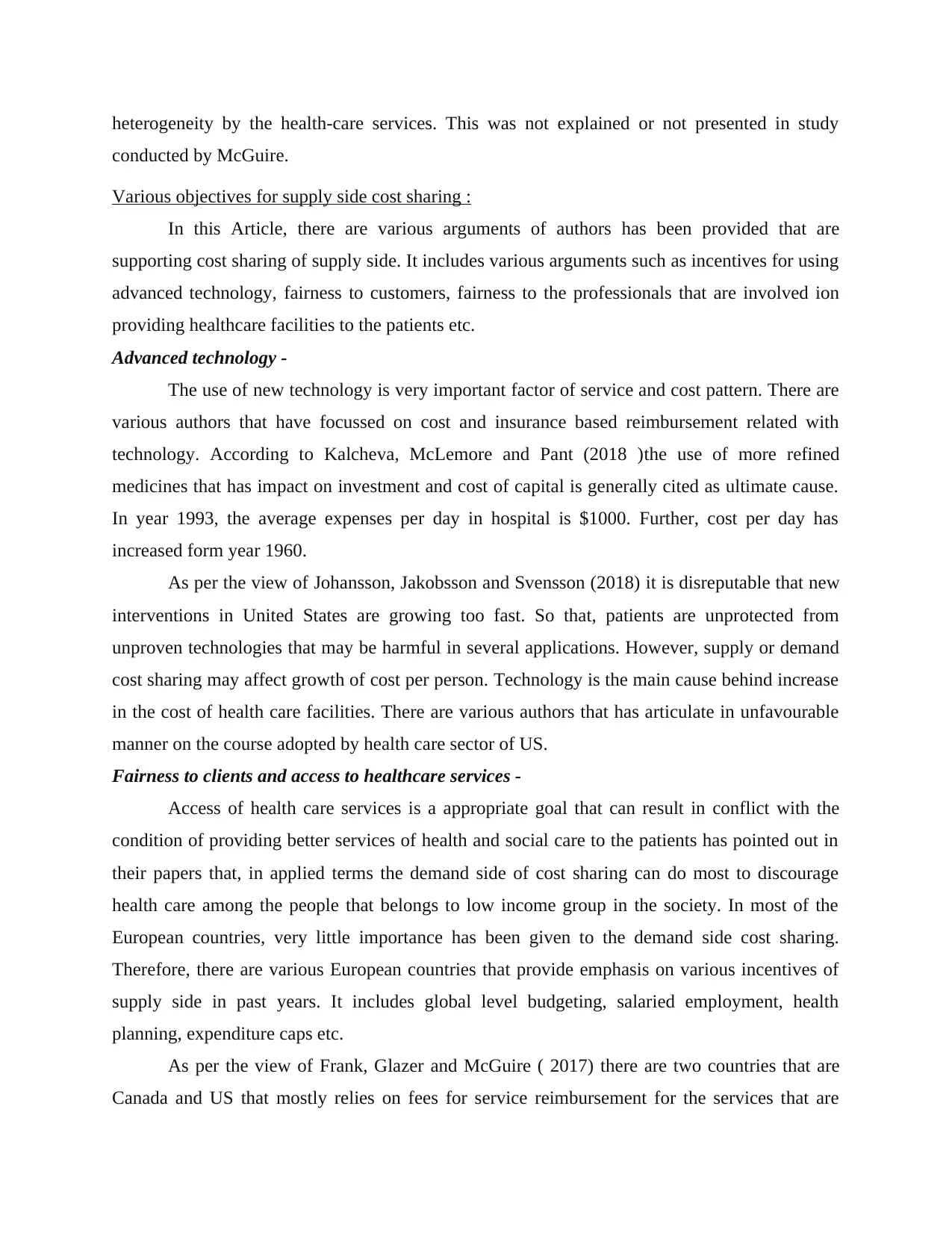
heterogeneity by the health-care services. This was not explained or not presented in study
conducted by McGuire.
Various objectives for supply side cost sharing :
In this Article, there are various arguments of authors has been provided that are
supporting cost sharing of supply side. It includes various arguments such as incentives for using
advanced technology, fairness to customers, fairness to the professionals that are involved ion
providing healthcare facilities to the patients etc.
Advanced technology -
The use of new technology is very important factor of service and cost pattern. There are
various authors that have focussed on cost and insurance based reimbursement related with
technology. According to Kalcheva, McLemore and Pant (2018 )the use of more refined
medicines that has impact on investment and cost of capital is generally cited as ultimate cause.
In year 1993, the average expenses per day in hospital is $1000. Further, cost per day has
increased form year 1960.
As per the view of Johansson, Jakobsson and Svensson (2018) it is disreputable that new
interventions in United States are growing too fast. So that, patients are unprotected from
unproven technologies that may be harmful in several applications. However, supply or demand
cost sharing may affect growth of cost per person. Technology is the main cause behind increase
in the cost of health care facilities. There are various authors that has articulate in unfavourable
manner on the course adopted by health care sector of US.
Fairness to clients and access to healthcare services -
Access of health care services is a appropriate goal that can result in conflict with the
condition of providing better services of health and social care to the patients has pointed out in
their papers that, in applied terms the demand side of cost sharing can do most to discourage
health care among the people that belongs to low income group in the society. In most of the
European countries, very little importance has been given to the demand side cost sharing.
Therefore, there are various European countries that provide emphasis on various incentives of
supply side in past years. It includes global level budgeting, salaried employment, health
planning, expenditure caps etc.
As per the view of Frank, Glazer and McGuire ( 2017) there are two countries that are
Canada and US that mostly relies on fees for service reimbursement for the services that are
conducted by McGuire.
Various objectives for supply side cost sharing :
In this Article, there are various arguments of authors has been provided that are
supporting cost sharing of supply side. It includes various arguments such as incentives for using
advanced technology, fairness to customers, fairness to the professionals that are involved ion
providing healthcare facilities to the patients etc.
Advanced technology -
The use of new technology is very important factor of service and cost pattern. There are
various authors that have focussed on cost and insurance based reimbursement related with
technology. According to Kalcheva, McLemore and Pant (2018 )the use of more refined
medicines that has impact on investment and cost of capital is generally cited as ultimate cause.
In year 1993, the average expenses per day in hospital is $1000. Further, cost per day has
increased form year 1960.
As per the view of Johansson, Jakobsson and Svensson (2018) it is disreputable that new
interventions in United States are growing too fast. So that, patients are unprotected from
unproven technologies that may be harmful in several applications. However, supply or demand
cost sharing may affect growth of cost per person. Technology is the main cause behind increase
in the cost of health care facilities. There are various authors that has articulate in unfavourable
manner on the course adopted by health care sector of US.
Fairness to clients and access to healthcare services -
Access of health care services is a appropriate goal that can result in conflict with the
condition of providing better services of health and social care to the patients has pointed out in
their papers that, in applied terms the demand side of cost sharing can do most to discourage
health care among the people that belongs to low income group in the society. In most of the
European countries, very little importance has been given to the demand side cost sharing.
Therefore, there are various European countries that provide emphasis on various incentives of
supply side in past years. It includes global level budgeting, salaried employment, health
planning, expenditure caps etc.
As per the view of Frank, Glazer and McGuire ( 2017) there are two countries that are
Canada and US that mostly relies on fees for service reimbursement for the services that are
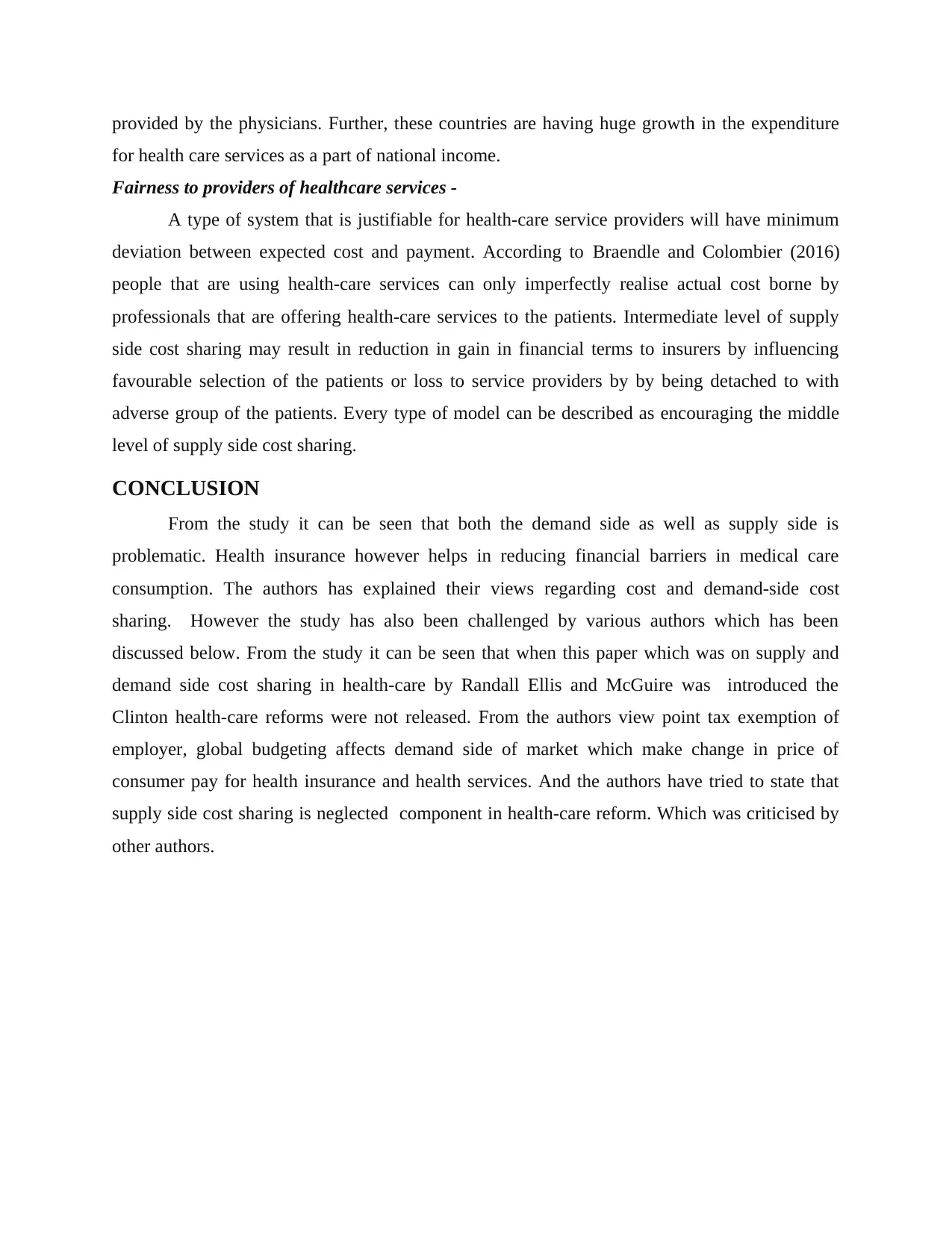
provided by the physicians. Further, these countries are having huge growth in the expenditure
for health care services as a part of national income.
Fairness to providers of healthcare services -
A type of system that is justifiable for health-care service providers will have minimum
deviation between expected cost and payment. According to Braendle and Colombier (2016)
people that are using health-care services can only imperfectly realise actual cost borne by
professionals that are offering health-care services to the patients. Intermediate level of supply
side cost sharing may result in reduction in gain in financial terms to insurers by influencing
favourable selection of the patients or loss to service providers by by being detached to with
adverse group of the patients. Every type of model can be described as encouraging the middle
level of supply side cost sharing.
CONCLUSION
From the study it can be seen that both the demand side as well as supply side is
problematic. Health insurance however helps in reducing financial barriers in medical care
consumption. The authors has explained their views regarding cost and demand-side cost
sharing. However the study has also been challenged by various authors which has been
discussed below. From the study it can be seen that when this paper which was on supply and
demand side cost sharing in health-care by Randall Ellis and McGuire was introduced the
Clinton health-care reforms were not released. From the authors view point tax exemption of
employer, global budgeting affects demand side of market which make change in price of
consumer pay for health insurance and health services. And the authors have tried to state that
supply side cost sharing is neglected component in health-care reform. Which was criticised by
other authors.
for health care services as a part of national income.
Fairness to providers of healthcare services -
A type of system that is justifiable for health-care service providers will have minimum
deviation between expected cost and payment. According to Braendle and Colombier (2016)
people that are using health-care services can only imperfectly realise actual cost borne by
professionals that are offering health-care services to the patients. Intermediate level of supply
side cost sharing may result in reduction in gain in financial terms to insurers by influencing
favourable selection of the patients or loss to service providers by by being detached to with
adverse group of the patients. Every type of model can be described as encouraging the middle
level of supply side cost sharing.
CONCLUSION
From the study it can be seen that both the demand side as well as supply side is
problematic. Health insurance however helps in reducing financial barriers in medical care
consumption. The authors has explained their views regarding cost and demand-side cost
sharing. However the study has also been challenged by various authors which has been
discussed below. From the study it can be seen that when this paper which was on supply and
demand side cost sharing in health-care by Randall Ellis and McGuire was introduced the
Clinton health-care reforms were not released. From the authors view point tax exemption of
employer, global budgeting affects demand side of market which make change in price of
consumer pay for health insurance and health services. And the authors have tried to state that
supply side cost sharing is neglected component in health-care reform. Which was criticised by
other authors.
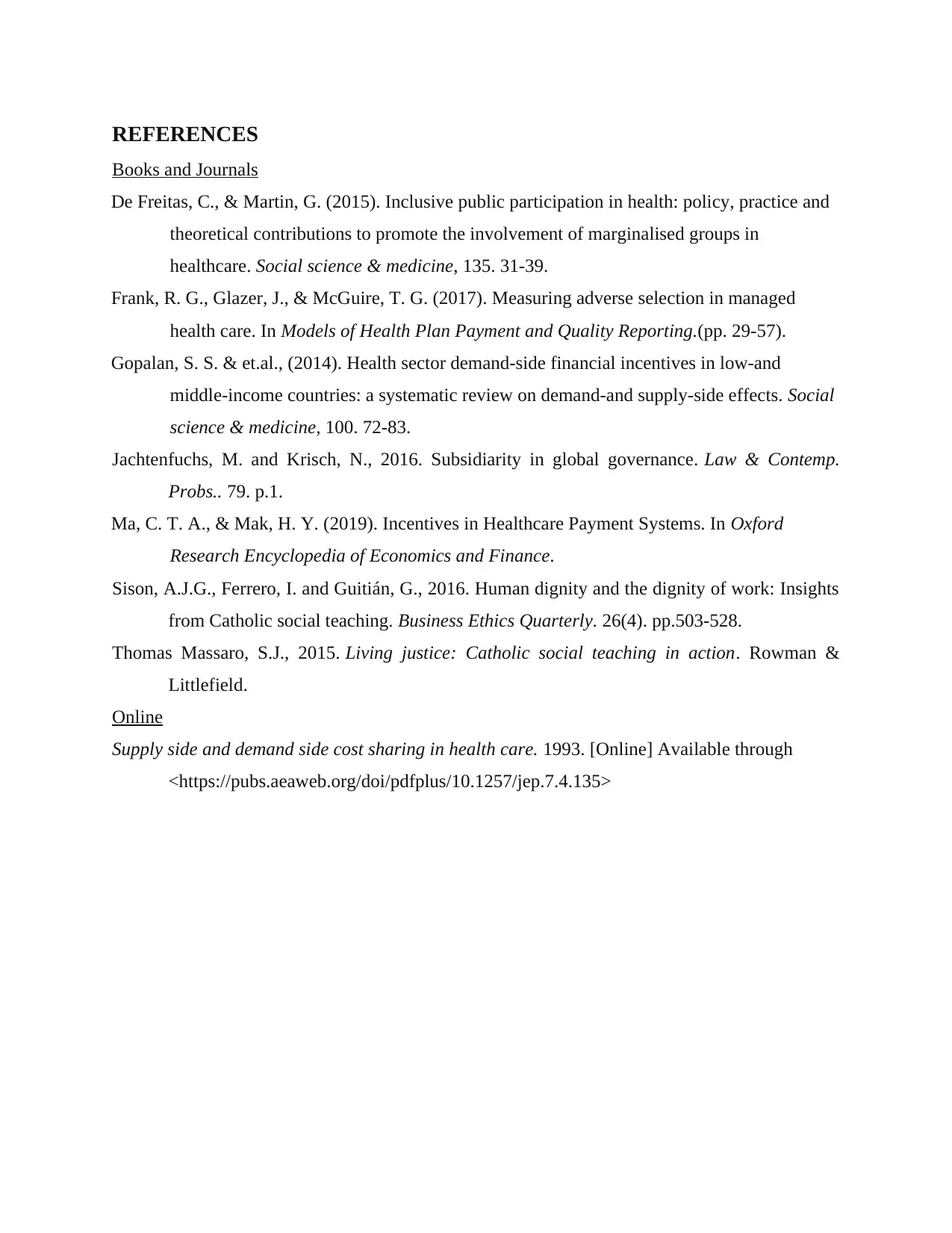
REFERENCES
Books and Journals
De Freitas, C., & Martin, G. (2015). Inclusive public participation in health: policy, practice and
theoretical contributions to promote the involvement of marginalised groups in
healthcare. Social science & medicine, 135. 31-39.
Frank, R. G., Glazer, J., & McGuire, T. G. (2017). Measuring adverse selection in managed
health care. In Models of Health Plan Payment and Quality Reporting.(pp. 29-57).
Gopalan, S. S. & et.al., (2014). Health sector demand-side financial incentives in low-and
middle-income countries: a systematic review on demand-and supply-side effects. Social
science & medicine, 100. 72-83.
Jachtenfuchs, M. and Krisch, N., 2016. Subsidiarity in global governance. Law & Contemp.
Probs.. 79. p.1.
Ma, C. T. A., & Mak, H. Y. (2019). Incentives in Healthcare Payment Systems. In Oxford
Research Encyclopedia of Economics and Finance.
Sison, A.J.G., Ferrero, I. and Guitián, G., 2016. Human dignity and the dignity of work: Insights
from Catholic social teaching. Business Ethics Quarterly. 26(4). pp.503-528.
Thomas Massaro, S.J., 2015. Living justice: Catholic social teaching in action. Rowman &
Littlefield.
Online
Supply side and demand side cost sharing in health care. 1993. [Online] Available through
<https://pubs.aeaweb.org/doi/pdfplus/10.1257/jep.7.4.135>
Books and Journals
De Freitas, C., & Martin, G. (2015). Inclusive public participation in health: policy, practice and
theoretical contributions to promote the involvement of marginalised groups in
healthcare. Social science & medicine, 135. 31-39.
Frank, R. G., Glazer, J., & McGuire, T. G. (2017). Measuring adverse selection in managed
health care. In Models of Health Plan Payment and Quality Reporting.(pp. 29-57).
Gopalan, S. S. & et.al., (2014). Health sector demand-side financial incentives in low-and
middle-income countries: a systematic review on demand-and supply-side effects. Social
science & medicine, 100. 72-83.
Jachtenfuchs, M. and Krisch, N., 2016. Subsidiarity in global governance. Law & Contemp.
Probs.. 79. p.1.
Ma, C. T. A., & Mak, H. Y. (2019). Incentives in Healthcare Payment Systems. In Oxford
Research Encyclopedia of Economics and Finance.
Sison, A.J.G., Ferrero, I. and Guitián, G., 2016. Human dignity and the dignity of work: Insights
from Catholic social teaching. Business Ethics Quarterly. 26(4). pp.503-528.
Thomas Massaro, S.J., 2015. Living justice: Catholic social teaching in action. Rowman &
Littlefield.
Online
Supply side and demand side cost sharing in health care. 1993. [Online] Available through
<https://pubs.aeaweb.org/doi/pdfplus/10.1257/jep.7.4.135>
1 out of 7
Your All-in-One AI-Powered Toolkit for Academic Success.
+13062052269
info@desklib.com
Available 24*7 on WhatsApp / Email
![[object Object]](/_next/static/media/star-bottom.7253800d.svg)
Unlock your academic potential
© 2024 | Zucol Services PVT LTD | All rights reserved.

